
Wissam Nassar for The New York Times
Tens of thousands of Hamas supporters gathered in Gaza City near a large replica of an M-75, a Hamas rocket, that bore the words “Made in Gaza.” More Photos »
GAZA CITY — Khaled Meshal, the political leader of Hamas, gave a defiant speech on Saturday, vowing to build an Islamic Palestinian state on all the land of Israel, the West Bank and the Gaza Strip.
Speaking before tens of thousands of supporters to celebrate the 25th anniversary of the founding of Hamas, Mr. Meshal said the Jewish state would be wiped away through “resistance,” or military action. “The state will come from resistance, not negotiation,” he said. “Liberation first, then statehood.”
His voice rising to a shout, Mr. Meshal said: “Palestine is ours from the river to the sea and from the south to the north. There will be no concession on any inch of the land.” He vowed that all Palestinian refugees and their descendants would one day return to their original homes in what is now Israel.
“We will never recognize the legitimacy of the Israeli occupation, and therefore there is no legitimacy for Israel, no matter how long it will take,” he said. “We will free Jerusalem inch by inch, stone by stone. Israel has no right to be in Jerusalem.” He also promised Palestinian prisoners held in Israel that they would be freed using the same methods that had worked in the past — the kidnapping of Israelis and Israeli soldiers, like Gilad Shalit, who was released last year in a prisoner exchange after five years as a hostage.
Mr. Meshal’s harsh words reflected longstanding Hamas principles rather than new, specific threats toward Israel. But they will only reinforce Israel’s belief that Hamas is its enemy and intends to continue to use military force to reach its goals.
The anniversary of Hamas’s founding is Dec. 14, but the organization moved the celebration forward to honor the first uprising against Israel.
Mr. Meshal, on his first visit to Gaza after 45 years of exile, having fled a West Bank village at 11 with his family during the 1967 Arab-Israeli war, was in a joyous but not conciliatory mood. He promised Palestinian unity, but only on the basis of Hamas’s principles, which would mean a subordinate role for Fatah, the main Palestinian faction in the West Bank. He called the United Nations General Assembly’s vote granting Palestinians enhanced status as a nonmember observer state — engineered by President Mahmoud Abbas of the Palestinian Authority, which governs the West Bank — “a small step but a good one.”
He insisted that Hamas had won a great military victory by achieving a cease-fire with Israel last month after eight days of rocket launchings and airstrikes, and said it could form the basis, with the General Assembly vote, of a new Palestine Liberation Organization that would contain all Palestinian factions. An inclusive Palestinian Authority and a P.L.O. based on Hamas principles, however, would almost surely find itself shunned by Israel and much of the world. It would also be a humiliating defeat for Mr. Abbas, who supports a two-state solution and has negotiated with Israel.
The P.L.O., run by Mr. Abbas of Fatah, is the sole legal representative of the Palestinian people and does not now include Hamas.
The celebration took place under cloudy skies, with periods of rain. But few of the supporters, many waving green Hamas flags, left the crowded square.
Mr. Meshal and Ismail Haniya, the Hamas prime minister in Gaza, emerged together from a giant replica of a Hamas rocket called the M-75, which is supposed to be able to travel about 45 miles from Gaza City, putting it close to Tel Aviv. Many experts have said they think the M-75 is a repainted Iranian Fajr rocket, but the one on display bore the words “Made in Gaza,” in English. The crowd cheered and a band played a song praising Hamas leaders for being fearless in the face of death.
The stage featured the rocket, a banner showing the walls of Jerusalem and the Dome of the Rock, and large photographs of Mr. Meshal and of Ahmed al-Jabari, Hamas’s military commander who was killed by an Israeli strike on the first day of November’s fighting.













